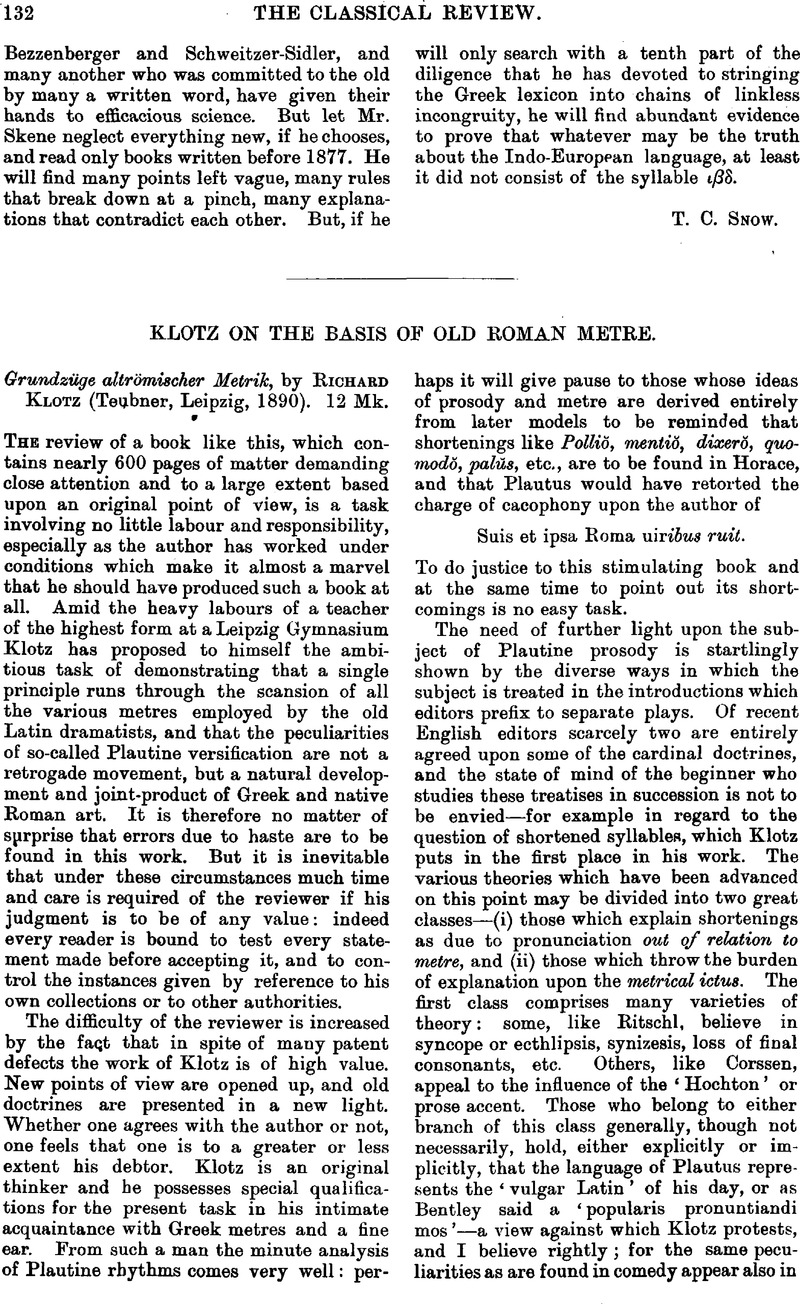No CrossRef data available.
Article contents
Klotz on the Basis of Old Roman Metre - Grundzüge altrömischer Metrik, by Richard Klotz (Teubner, Leipzig, 1890). 12 Mk.
Published online by Cambridge University Press: 27 October 2009
Abstract

- Type
- Book Review
- Information
- Copyright
- Copyright © The Classical Association 1893
References
page 133 note 1 It does not follow that it became as short as an ordinary short syllable. Klotz has some good remarks about half-short syllables.
page 133 note 2 Whether the ‘ Kiirzungsgesetz’ (law of shortening) should be called with Klotz a metrical phenomenon pure and simple, or a linguistic phenomenon, as Skutsch calls it in his Forschungen, recently noticed by Mr. W. M. Lindsay in the Classical Review (vi. 9), is another question, and the answer depends on how we understand these terms. If by ‘linguistic’ is meant such as reproduces the prose accent, then such scansions as obsecrǒ resist the application of the term. On the other hand if by ‘metrical’ is meant a mere arbitrary shortening by the scenic poets of syllables which by the laws of speech were long, then it would certainly be hazardous to employ it. All that we can say is that the verse ictus often overrides the prose accent: when they come into conflict, the prose accent is sacrificed in the interests of the metre. But this sacrifice need not have involved a violation of the laws of sound: obsécrǒ is after all a very similar phenomenon to uenǐ. One thing seems clear, that we must be very cautious about altering the text merely because the metrical ictus falls upon an unusual place of a word. Thus when Mr. Lindsay (C.R. vi. 8, p. 342) wishes to emend Asin. 241 Pórtitorum símǐllumae sunt iánuae lenóniae because in other passages (Asin. 215, Bacch. 913, Cist. 81) Plautus writes simíllumus, he is on very uncertain ground: merely in order to get rid of an easily explicable phenomenon he has to assume a wholly unknown form or pronunciation (Portorum or Porttorum for Portitorum). Moreover I should like to see the evidence of Mr. Lindsay's statement that all superlatives uniformly have the ictus on the antepenultimate in Plautus. What does he say to Aul. ii. 1. 19 optúma, Pers 543 séd ǒptume, Most. 410 uél ǒptumò uel péssumo, to say nothing of cases like Amph. 552, 561 sceléstìssumus, where the principal ictus is on the second syllable?
page 134 note 1 I employ the dot above the syllable to indicate the word-accent; the acute accent to indicate the principle ictus of the dipody; the grave accent to indicate the secondary ictus of the dipody.
page 134 note 2 Klotz (p. 65) speaks of a ‘Kräftiger Einsatz’ as explaining brerǐ án longinqno at the beginning of a line; but this is quite inapplicable to the middle of a line. On p. 94 he admits an ‘Anlehnung an das Folgende.’
page 134 note 3 He proposes Sed me ūxor scelerata for Sed ŭxór scelesta Observe that he is debarred from Sed ūxor scelěsta by bis own act.
page 135 note 1 This explains only the accentuation, not the quantity; the statement (p. 92) that the shortened uolǔptas appears only in the phrase uoluptás mea at the end of a verse may easily mislead: it is true only of the Nominative Singular; the oblique cases are frequently shortened in the middle of a line, e.g. Amph. 939 Capiúnt uolŭptàtes, cápiunt rùrsum míserias, Merc. 548 Volŭptàte, Cas. 426 and 557 uólŭptatém, etc. Mr. Lindsay's statement (C.R. vi. 8, p. 342) must also be taken subject to the same limitation. It would be strange indeed if uoluptas stood on a different footing from uoluntas.
page 135 note 2 That an elided syllable is not entirely obliterated is of course obvious and several times explicitly stated by Klotz.
page 135 note 3 Merc. 176 T ![]() quidem ěx ore might have been easily got rid of by reading T
quidem ěx ore might have been easily got rid of by reading T ![]() quidem ēx ore: see Bücheler in Archiv. iii. pp. 144–146.
quidem ēx ore: see Bücheler in Archiv. iii. pp. 144–146.
page 135 note 4 A new explanation of this phenomenon is given by Skutseh, Forschungen (see Class, Rev. vi. 9).




